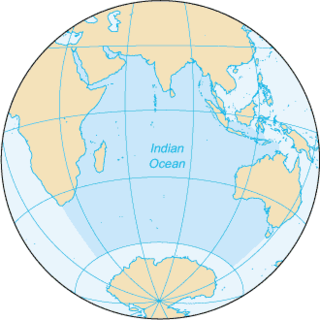
The lowfin gulper shark is a large deepwater dogfish in the Centrophoridae family.
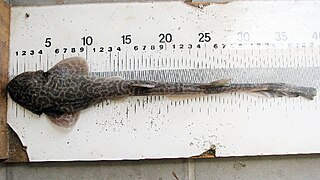
Holohalaelurus is a genus of catshark in the family Scyliorhinidae, commonly known as Izak catsharks or hallelujah sharks.
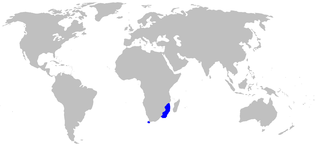
The white-spotted Izak or African spotted catshark is a catshark of the family Scyliorhinidae. It is found in the western Indian Ocean off the coasts of Natal, South Africa, southern Mozambique, Madagascar, Kenya, and Tanzania between latitudes 4° S and 37° S, at depths of between 220 and 440 m. It can grow up to 35 cm in length.

The Izak catshark or simply Izak is a species of catshark, belonging to the family Scyliorhinidae, common off the coasts of South Africa and southern Namibia. It typically inhabits the outer continental shelf at depths of 100–300 m (330–980 ft), with the males found deeper than the females and juveniles. The Izak catshark has a short, wide, flattened head and a robust body tapering to a long, slender tail. It can be identified by its ornate color pattern of dark brown spots or reticulations and blotches on a light yellowish background, as well as by the enlarged dermal denticles over its pectoral fins and along its dorsal midline from the snout to the second dorsal fin. This species reaches 69 cm (27 in) in length, with the males larger than females.
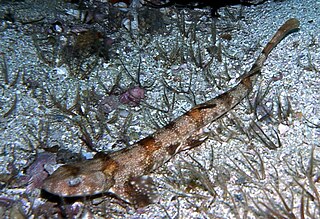
Haploblepharus is a genus of catshark, and part of the family Scyliorhinidae, containing four species of shysharks. Their common name comes from a distinctive defensive behavior in which the shark curls into a circle and covers its eyes with its tail. The genus is endemic to southern Africa, inhabiting shallow coastal waters. All four species are small, stout-bodied sharks with broad, flattened heads and rounded snouts. They are characterized by very large nostrils with enlarged, triangular flaps of skin that reach the mouth, and deep grooves between the nostrils and the mouth. Shysharks are bottom-dwelling predators of bony fishes and invertebrates. They are oviparous, with the females laying egg capsules. These harmless sharks are of no commercial or recreational interest, though their highly limited distributions in heavily fished South African waters are of potential conservation concern.

The striped smooth-hound is a houndshark of the family Triakidae, found on the continental shelves of the subtropical southwest Atlantic from southern Brazil to northern Argentina between latitudes 30° S and 47° S, from the surface to 250 m. It can grow up to a length of 1.5 m. The reproduction of this shark is Ovoviviparous, with the length at birth up to 39 cm.
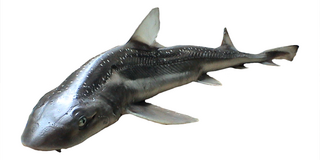
The starspotted smooth-hound is a houndshark of the family Triakidae. It is found in east Asia and in the western Indian Ocean between latitudes 45° N and 10° S, from the surface to a depth of 360 m. The reproduction of this shark is Ovoviviparous.

The cylindrical lanternshark or Carter Gilbert's lanternshark is a shark of the family Etmopteridae found along the Caribbean coast of Colombia in South America, at depths of between 285 and 355 m. Its maximum length is 21 cm.

The dense-scale lanternshark is a shark of the family Etmopteridae found in the southeast Pacific off Peru and Chile.

The fringefin lanternshark is a shark of the family Etmopteridae found in the western central Atlantic from Texas to Florida, northern Gulf of Mexico, and Mexico.

The Caribbean lanternshark is a shark of the family Etmopteridae found in the eastern and western Atlantic at depths between 180 and 720 m. Its length is up to 50 cm.

The African lanternshark is a shark of the family Etmopteridae found in the eastern Atlantic between latitudes 12°N and 18°S, at depths between 300 and 1,000 m. Its length is up to 30 cm.
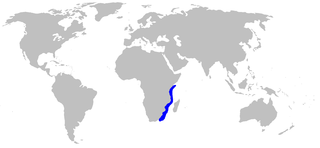
The thorny lanternshark is a shark of the family Etmopteridae found in the western Indian Ocean between latitudes 0° and 31°S, at depths between 200 and 500 m. Its length is up to 27 cm.

The false lanternshark or false pygmy shark is a shark of the family Etmopteridae found in the western Pacific from the Norfolk Ridge and Lord Howe Ridge off New Caledonia.

Hasselt's bamboo shark is a bamboo shark in the family Hemiscylliidae found around Thailand, Malaysia and Indonesia, between latitudes 23° N and 10° N, and longitude 91° E and 133° E; residing inshore. Its length is up to 60 cm.

Callochromis melanostigma is a species of cichlid endemic to Lake Tanganyika where it prefers sandy bottoms with nearby rocks. This fish grows to a length of 15 centimetres (5.9 in) TL. It is also found in the aquarium trade.
The grinning Izak or East African spotted Izak is a type of catshark in the waters of the Western Indian Ocean, near Kenya.
The honeycomb Izak or Natal Izak is a type of catshark in the Western Indian Ocean, near South Africa. It reaches a maximum length of around 50 cm. Since the mid-1970s, no specimens have been collected, even with recent biodiversity research cruises.


